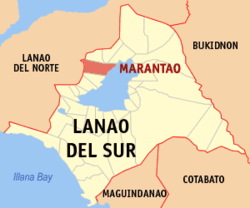Marantao, Lanao del Sur
| Marantao | |
|---|---|
| Municipality | |
 Map of Lanao del Sur with Marantao highlighted | |
.svg.png) Marantao Location within the Philippines | |
| Coordinates: 07°57′N 124°14′E / 7.950°N 124.233°ECoordinates: 07°57′N 124°14′E / 7.950°N 124.233°E | |
| Country | Philippines |
| Region | Autonomous Region in Muslim Mindanao (ARMM) |
| Province | Lanao del Sur |
| Barangays | 34 |
| Government[1] | |
| • Mayor | Racma Bandrang K. Abinal |
| Area | |
| • Total | 660.00 km2 (254.83 sq mi) |
| Population (2015 census)[2] | |
| • Total | 32,974 |
| • Density | 50/km2 (130/sq mi) |
| Time zone | PST (UTC+8) |
| ZIP code | 9711 |
| IDD : area code | +63 (0)63 |
| Income class | 2nd municipal income class |
| PSGC | 153616000 |
| Electorate | 20,793 voters as of 2016 |
| Website |
www |
Marantao is a second class municipality in the province of Lanao del Sur, Philippines. According to the 2015 census, it has a population of 32,974 people.[2]
Kawayan Torogan
The Kawayan Torogan is the oldest known torogan in the Philippines. It is a traditional Maranao house built for royal Maranao families. There was once a campaign where the people wanted the municipalities of Marantao and Tugaya to pass an ordinance where the architectural scheme of the two towns will follow only the totogan style, in effect, preserve the Maranao people's most royal architectural style and lead to the first two towns with a planned town landscape under an indigenous Maranao architecture. However, the campaign led to deaf ears due to little funding available.
Barangays
Marantao is politically subdivided into 34 barangays.
- Bacayawan
- Cawayan Bacolod
- Bacong
- Camalig Bandara Ingud
- Camalig Bubong
- Camalig (Pob.)
- Inudaran Campong
- Cawayan
- Daanaingud
- Cawayan Kalaw
- Kialdan
- Lumbac Kialdan
- Cawayan Linuk
- Lubo
- Inudaran Lumbac
- Mantapoli
- Matampay
- Maul
- Nataron
- Pagalongan Bacayawan
- Pataimas
- Poona Marantao
- Punud Proper
- Tacub
- Maul Ilian
- Palao
- Banga-Pantar
- Batal-Punud
- Bubong Madanding (Bubong)
- Ilian
- Inudaran Loway
- Maul Lumbaca Ingud
- Poblacion
- Tuca Kialdan
Demographics
| Population census of Marantao | ||
|---|---|---|
| Year | Pop. | ±% p.a. |
| 1918 | 3,640 | — |
| 1939 | 6,783 | +3.01% |
| 1948 | 2,494 | −10.52% |
| 1960 | 13,720 | +15.26% |
| 1970 | 15,861 | +1.46% |
| 1975 | 16,496 | +0.79% |
| 1980 | 11,777 | −6.52% |
| 1990 | 18,404 | +4.57% |
| 1995 | 20,942 | +2.45% |
| 2000 | 24,647 | +3.55% |
| 2007 | 32,075 | +3.70% |
| 2010 | 28,550 | −4.15% |
| 2015 | 32,974 | +2.78% |
| Source: Philippine Statistics Authority[2][3][4] | ||
References
- ↑ "Official City/Municipal 2013 Election Results". Intramuros, Manila, Philippines: Commission on Elections (COMELEC). 1 July 2013. Retrieved 5 September 2013.
- 1 2 3 Census of Population (2015). "ARMM - Autonomous Region in Muslim Mindanao". Total Population by Province, City, Municipality and Barangay. PSA. Retrieved 20 June 2016.
- ↑ Census of Population and Housing (2010). "ARMM - Autonomous Region in Muslim Mindanao". Total Population by Province, City, Municipality and Barangay. NSO. Retrieved 29 June 2016.
- ↑ Census of Population (1995, 2000 and 2007). "ARMM - Autonomous Region in Muslim Mindanao". Total Population by Province, City and Municipality. NSO. Archived from the original on 11 November 2011.
External links
- Philippine Standard Geographic Code
- Philippine Census Information
- Local Governance Performance Management System
